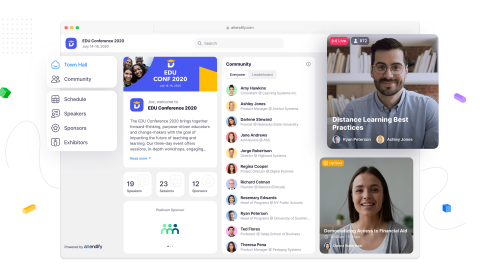Live webinars are a crucial B2B approach for involving clients, staff members, and business partners in the age of virtual events. However, a live internet meeting may go very badly. Pre-recording both video and audio content before the live event is one of the greatest virtual event tips for clients. One issue that is asked more frequently as more companies utilize virtual events to interact with their customers is: “When is it best to depend on pre-recorded material, and when is it beneficial to employ a live format?” It’s an excellent query. Businesses are under a significant amount of pressure these days to communicate high-risk, high-impact information to important audiences like investors, so it’s necessary to choose the appropriate format in the digital space.
Benefits of Pre-recorded Content
In essence, the benefits of presenting pre-recorded virtual events outweigh the drawbacks of live virtual events. Pre-recorded content necessitates more preparation and pre-production, but lowers anxiety during event execution because there are fewer potential pitfalls.
-
More flexible
It is simpler to incorporate more speakers across various time zones and content formats when using pre-recorded content. A pre-recorded format enables one to perform numerous takes until they achieve the desired result if they are attempting to pull off a difficult presentation that calls for one to seamlessly combine various technologies, such as for a product demo.
-
Retakes
What one observes is what they get when giving a presentation in real time, for one thing. all flaws and all. The speaker makes a mistake? It’s active. The slide deck’s computer fails, what should I do? It’s active. Suddenly, the speaker’s microphone fails? It’s active.
-
Perfect for educational material
A taped video enables one to film and edit if they are the one offering the insights into a subject in each scenario (without audience interaction).
-
Suitable for quick distribution
If one can prepare ahead of time, then one can edit, post, and share a pre-recorded video more quickly. A pre-recorded video might be quite helpful if one is presenting vital news and wants to have remarks open for fast playback.
-
Less errors and pressure
Because everything was recorded beforehand, any mistakes may be removed. The concern that a speaker would say anything incorrect or contentious is unfounded because such blunders can be removed from the tape, allowing the planners and moderators to relax.
The fact that an event is pre-recorded and not live is one of its benefits. This implies that the speakers are under less pressure since they may feel more at ease knowing that they can redo any awkward sequences or phrases. Because they are less prone to be forced to provide any live troubleshooting, it is also far less hectic for the technical supervisors of the virtual events.
Benefits of Going Live
-
Cost
There aren’t many additional requirements while conducting a live streaming session, in most cases. It may only require a mobile or pc with a webcam and a current account with a broadcasting provider, depending on how basic one wants to go. In the majority of live-streamed presentations, just one or more persons are talking. Almost none of the special effects are present. However, several bigger corporate companies have a reputation for making significant aesthetic investments in their keynote presentations. Can a presentation that is live-streamed have a high production value? Yes, but they tend to be the exception rather than the rule. Going live might also helps in saving time as well as money. Due to time restrictions, live events virtually ever have the opportunity to use elaborate visual effects, animations, and transitions, which necessitates less editing.
-
Interaction
With today’s streaming systems, the presenter may engage with their audience by playing games, taking polls, and asking questions by using a variety of applications. The whole nature of live broadcasting services is one of community. The freedom that comes with being live extends to both engagement and content that is displayed. One could regret not practicing more if they spend 10 hours recording a pre-recorded video only to learn the next day that a crucial element of information has changed. One just has to have some flexibility to modify and adapt.
-
Time
Live-streamed material needs less time since there is typically less production required, even if there is always a significant amount of time engaged in a presentation—research, finding assets, rehearsing. There is a good reason why certain information is pre-produced; the presentation calls for more labor-intensive tasks and higher production standards, both of which require time to complete.
-
Immediacy
The sensation that one witnesses something while it is happening has merit. There is a stronger relationship. It seems more affable.
-
Authenticity
When opposed to pre-recorded content, livestreams have a higher level of authenticity since their audience may view them in all of their raw, unadulterated beauty. Real-time events are depicted on the screen as they happen, giving the scene a considerably more dynamic feel. It’s the closest thing to being there in person. Additionally, one can also increase audience participation by live-streaming the entire event. Voting or Q&A sessions are open to the audience. A presentation just feels more authentic when it is delivered live. A presenter taking a glass of water makes him seem more human, which helps the audience relate to him better.
Conclusion
Live streaming as well as pre-recording have their advantages in their own right. Whether the demonstrations done live or be pre-produced is one of the more important decisions a virtual event organizer must make. Both parties have their points of contention. Pre-recording often ensures the event runs without a hitch while live-streaming enables more natural, human engagement. To achieve the ideal balance for an event, one may also combine and blend pre-recorded material with live-streaming segments. It’s probably the simple way out for me to state that both are significant, but it’s true that they both contribute to virtual events. As we’ve seen, maintaining a balance between strong attendee involvement and a reliable platform, like Mixhubb, is necessary for any event to succeed. Additionally, if one likes to hold a fantastic event by doing only either of them.


